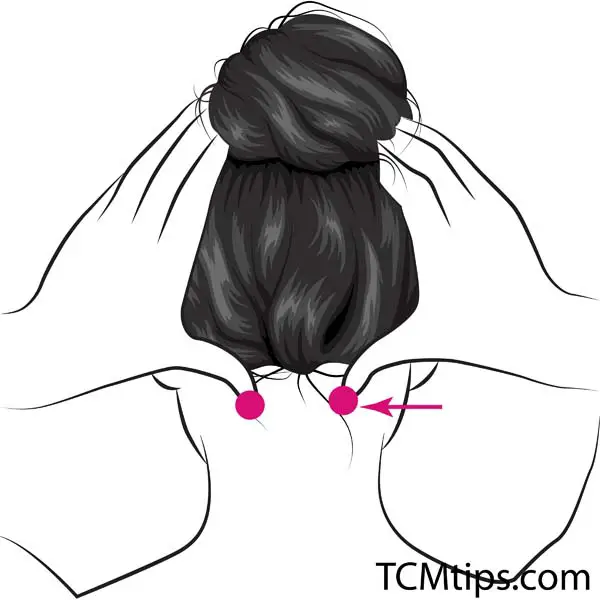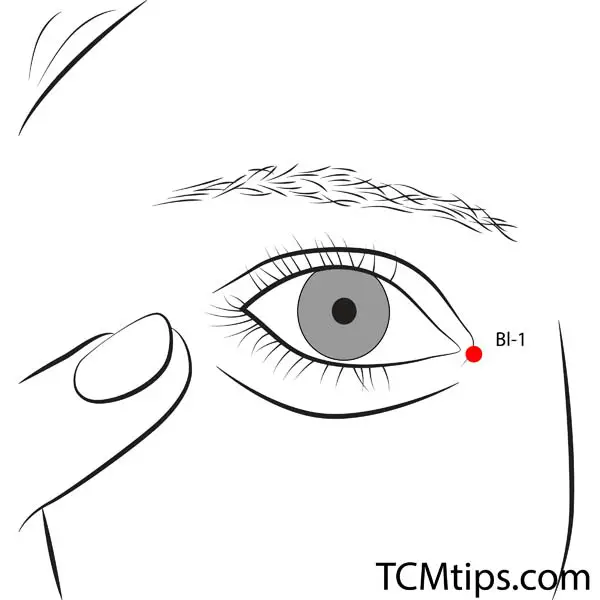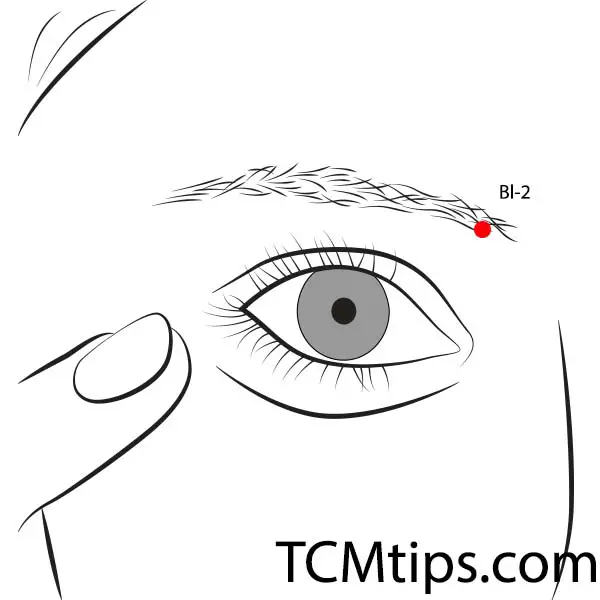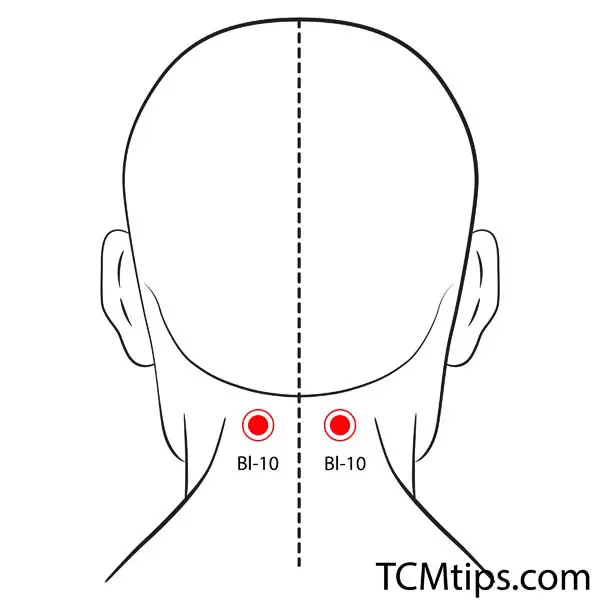Knowing multiple acupressure points is important for treating a variety of conditions, but sometimes it can be difficult to keep all of those points in mind. With hundreds of acupressure points in existence and each having its own specific influences on the body, you want to be sure you are not activating the incorrect point. This is when it is useful to have one point that is both versatile and easy to remember. For me, that has become the feng chi point.
The feng chi acupressure point has been my go-to treatment point for many years. Even when I am tired or in too much discomfort to think clearly, this point is easy to recall, and it really does it all. If you are looking for an acupressure point that can help with day-to-day discomforts in an easy way, then the GB-20 acupressure point is worth learning.
Acupoint: GB-20 (Other Names: Gallbladder-20/Feng Chi/Wind Pool)
 The feng chi acupuncture point is one of many pressure points in the neck, but it deserves its own special section in Chinese Medicine. This gallbladder channel point is perfectly positioned to influence the velocity of blood flow, especially between the brain and body. Maintaining healthy blood pressure and good circulation is key to keeping your body in good health. Blood velocity can affect everything from discomfort, to the healing of wounds, recovering from a cold, and even brain function. Studies have shown that stimulating the GB-20 acupuncture point, gall bladder 20, can both increase blood velocity and decrease blood velocity depending on your body’s needs. In the end, regular activation of this point will leave you with ideal blood flow throughout your body.
The feng chi acupuncture point is one of many pressure points in the neck, but it deserves its own special section in Chinese Medicine. This gallbladder channel point is perfectly positioned to influence the velocity of blood flow, especially between the brain and body. Maintaining healthy blood pressure and good circulation is key to keeping your body in good health. Blood velocity can affect everything from discomfort, to the healing of wounds, recovering from a cold, and even brain function. Studies have shown that stimulating the GB-20 acupuncture point, gall bladder 20, can both increase blood velocity and decrease blood velocity depending on your body’s needs. In the end, regular activation of this point will leave you with ideal blood flow throughout your body.
Aside from its wide-reaching benefits and its lack of downsides, the feng chi acupuncture point is also valuable for its ease of activation. Anatomically speaking, the mirrored points of GB-20 are located a the junction of the Sternocleidomastoid muscle and Trapezius muscles, which fall slightly beneath the base of the skull on the upper neck.
This location may sound complicated, but most people can access both halves of the feng chi point all on their own. You simply need to hold both hands with your finger facing, your thumbs pointing towards each other, and your palms facing out. While keeping your hands in this position, move them behind your head and place your thumbs at the base of your skull. Slide your thumbs past the base of your skull, and you should feel two slight indents on either side of the vertebrae in your neck muscles. Apply deep pressure here for a few seconds at a time to activate the feng chi point.
Acupressure Points For Eyestrain And Headache
Acupoint: Bl-1 (Other Names: Urinary Bladder-1/Jing Ming/Bright Eyes) & Acupoint: GB-20 (Other Names: Gallbladder-20/Feng Chi/Wind Pool)

Since the GB-20 acupressure point improves circulation, it can enhance the benefits of other points when used in combination. One such point is Bl-1 or the bright eyes point. This point is known amongst facial acupressure points for dark circles because it refreshes and relaxes the eyes. This combination is powerful when it comes to treating eye strain and acupressure for headaches.
The bright eyes point is located at the inner corner of each eye, and you will want to apply pressure with care, as this is a sensitive area. You can use your thumb to press in on this area and draw small circles in a series of 10 or 15 rotations.
Acupoint: EM-3 (Other Names: /Yu Yao/) & Acupoint: GB-20 (Other Names: Gallbladder-20/Feng Chi/Wind Pool)

EM-3 is another great point to use in combination with GB-20 for effective headache relief. This point falls in an area of the face where tension normally builds, earning it a place on lists of facial acupressure points for wrinkles, but this also makes it ideal for relieving discomfort around the eyes.
Located right in the center of either eyebrow, EM-3 is rather easy to locate and activate. Combine pressure in this area with gentle circular motions for 10 seconds or so, and you can repeat this motion with your feng chi point for maximum results.
Acupressure Points For Brain Fog And Drowsiness
Acupoint: Bl-2 (Other Names: Urinary Bladder-2/Zan Zhu/Gathered Bamboo) & Acupoint: GB-20 (Other Names: Gallbladder-20/Feng Chi/Wind Pool)

This urinary bladder point is ideal for activating facial nerves, which is why it is commonly referenced in lists on acupressure points for facial paralysis. This nerve stimulation also aids in stimulating the mind to help you feel refreshed and awake. When combined with improved blood circulation in the neck and shoulders from gb-20, this point becomes an instant fix for brain fog and drowsiness.
Much like EM-3, Bl-2 is located on the eyebrows. This point can be felt at the inner corner of the brow right on the bone.
Acupressure Points For Neck Pain
Acupoint: Bl-10 (Other Names: Urinary Bladder-10/Tian Zhu/Celestial Pillar) & Acupoint: GB-20 (Other Names: Gallbladder-20/Feng Chi/Wind Pool)

Neck pain can be difficult to live with and even harder to treat. When GB-20 is combined with bladder channel acupoint 10 they become the ideal treatment method for a stiff neck. This combination is so great at relieving neck pain that it was actually reached and found to have a significant therapeutic effect. On top of relieving pain, this point is also one of a few acupressure points for swollen lymph nodes in neck, making for twice the relief.
The Bl-10 points are located slightly beneath the GB-20 points, making them easy to activate in unison. You can hold the GB-20 points with firm thumb pressure for a few seconds while slowly pivoting your neck muscles, then you can repeat this motion as you move your fingers slightly lower to the Bl-10 points.

Try our Anti-Aging Gua Sha Tool designed to bring out your skin’s natural glow.
Best Gua Sha Product- Anti-Aging: The tool is designed to target 11 specific aging signs such as wrinkles and sagging skin. By following the 7-step routine, users can improve skin firmness and reduce fine lines naturally.
- Enhances Skincare Routine: It works effectively with serums and lotions, boosting absorption and efficacy of skincare products.
- Visible Skin Improvement: Users can expect a smoother complexion, reduced puffiness, and a more youthful appearance.
 P. Sze
P. Sze 

















